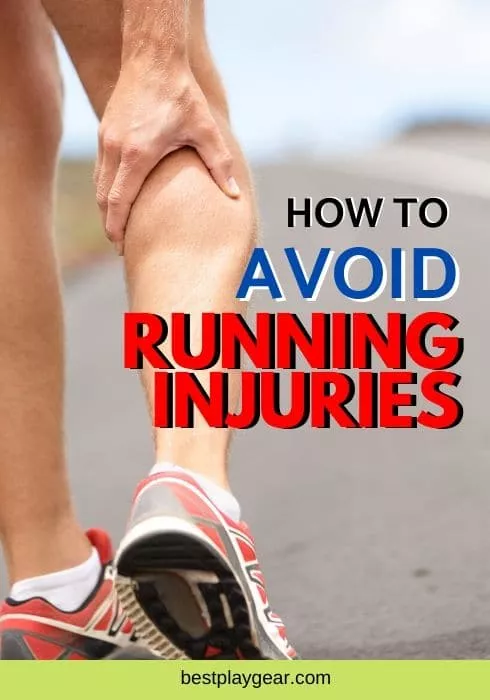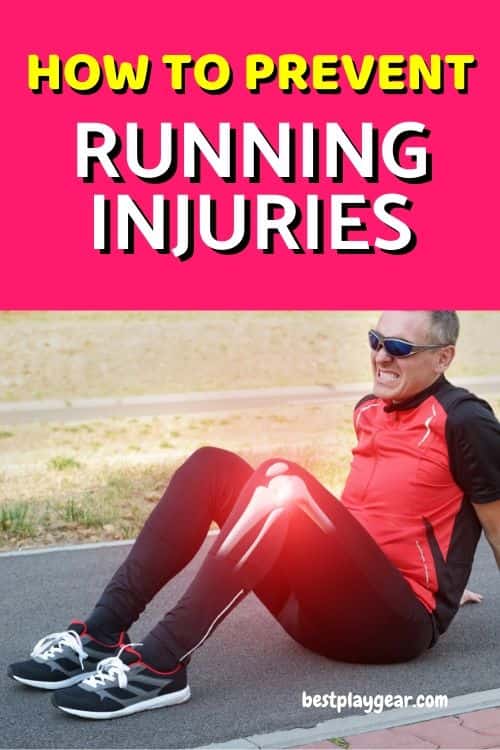[aff_disclosure]

During my initial days of weight loss, I just knew this – if I have to lose weight I need to sweat. The more I run the better it is. So the quantity was always the goal. Then one fateful day – I remember a snap pain in my knee which forced me to stop the treadmill. The pain was so sharp that I could not stand. And that was my first tryst with running overuse injury.
In this post, I have provided all the details I could to avoid and deal with overuse injuries. I don’t want you to go through the same pain that I have endured.
How to avoid running overuse injuries?
Some form of running injuries is inevitable when you are running for some time.
However, with a little precaution, you can play safe and avoid it as much as possible.
Gradually increasing your training
As a new runner, you are always in a hurry to chase your dream.
I completely get it. I was guilty of that.
But is this really correct?
Are you not pushing yourself hard?
On the contrary, design a practical and balanced training plan.
It is more so if you want to run big races like half-marathon, marathon, etc.
Related: Zero To Half-Marathon Training Plan For Beginners On Couch
If you have just started to run it is not possible that you can run 20min a day for 5 days a week.
If you try, you will be exerting too much pressure on your knees.
You need to build up the stamina and strengthen your muscles first.
You may follow the above plan, or create a plan of your own using something like below.
A sample running plan for a beginner would be:
Week 1
This week you will be working out for 3 days
Day 1 – Walking for 15 min at a moderate pace
Day 2 – Rest day
Day 3 – 2 min alternate jogging and walking for 15-20 min
Day 4 – Rest day
Day 5 – Strength training for 30 min
Week 2 – Same as week 1
By now your body will start responding to workout and the initial stiffness would have come down.
Now it is the time to accelerate but not in full throttle but gradually:
Week 3
Here you may increase your workout days to 4 or 5 but you will not only be running.
Day 1 – 2 min of alternate walking and running/jogging for 20 min
Day 2 – Strength training for 30 min
Day 3 – 4 to 5 min alternate walking and running/jogging for 20 min
Day 4 – Cross-training exercises like cycling or swimming
Day 5 – 20-30 min brisk walking.
Week 4 onwards you can gradually increase your running.
I am sure some of you would feel this is a very slow progression.
Trust me, if you are too fast initially, you will end up with injuries.
For any training, you should not increase your workout by more than 8-10 % in consecutive weeks.
Count on the technique
By running technique, I mean your running form and posture.
You may be committing these mistakes unknowingly.
Running with the wrong posture can lead to stiffness and strain in muscles.
This may lead to an overuse injury.
A classic example of this is the Runner’s knee.
Recovery
When you run, your muscles are working really hard to support you.
If you are using these muscles without giving rest, there are chances of these muscles to be worn out.
The stress may settle and it can become a persistent problem in the long run.
You must limit your training plan to the utmost 5 days a week.
It is a good idea to apply an ice pack or heat packs to your sore muscles.
They really help in faster recovery.
Good pain vs bad pain
No pain no gain is the mantra that most of the fitness enthusiasts follow.
Are all kinds of pain good for you?
While you are running or working out, you would have felt the pain in the muscles.
This pain may subside after your workout and recovery.
So, the next day you are all set to take up the challenge again.
This is what we call a good pain.
But let’s say you felt like something popped and then there is a sharp pain, or you felt a sharp pain somehow, then that may not be the right sign.
Consult your physician immediately.
Warm-up
It is a must for your workout regime, whether you are running or doing any other kind of workout.
It is really OK to spend 10-15 min on warmup rather than giving up on your workout.
A good warm-up may reduce the stiffness of the muscles and make your bones and joints more flexible.
A stiff muscle is more susceptible to injury.
You can opt for brisk walking or jogging before the run.
Alternately jumping jacks, squats or lunges are also good options.
What is running overuse injuries?
Running overuse injuries is an overuse injury that develops because of overusing any of the muscles.
Running is a complex exercise.
Though it may appear a simple run, it involves almost all of the lower parts of your body.
And that includes your hip flexors, thighs, knees, calves, ankles, and feet.
Sometimes, any of these may get overstressed and cause pain and discomfort.
The next question that pops up in your mind is why me?
One size fits all is not always the case in running.
Not everyone has the same body structure and muscle strengths.
You may feel the stress in some parts whereas your co-runner would feel stress somewhere else.
It completely depends on how your body is responding.
As I said, I had severe knee pain.
This was the runner’s knee condition because of the improper alignment of my knee cap and thigh bone.
You may face any other problem like ankle pain or pain around the tibia.
Here are some common reasons that may lead to running injuries due to overuse:
Inadequate recovery – Longer exertion hours with insufficient rest is one of the most common causes of running-related injuries. Repetitive usage of the same muscles makes them sore and causes aches. To prevent this try having proper recovery time and you can try different types of exercises to balance the stress.
Improper shoes or types of equipment – Your shoes are the most essential part of your running gear. They carry you long and you must be very careful while you pick your running shoes. The wrong kind of shoes will almost always lead you to injury.
Related: Recommended Gears: My performance-tested picks
Technique error – This is mostly seen in the new runners. As a new runner, your prime focus is mileage and pace. You may overlook the form and posture. If your posture is not correct you are quite susceptible to injury.
Pre-existing medical condition – Unfortunately, this is not in your hands. Sometimes the problem arises due to existing medical conditions like diabetes, foot overpronation, previous injury. There is nothing much you can do about it. All you need to do is to be more careful and take necessary precautions.

Running injuries are rampant among runners. Here is how you can prevent running injuries.
What can you proactively do to prevent running injury?
Here are a couple of things that you can do to prevent overuse running injuries:
Post-run Stretches
We have spoken about the warm-up part of the workout.
equally important are the post-run stretches.
They help in eliminating any kind of stress that settles in your muscles, joints or softer tissues.
When you run, your entire lower body is in action to support you.
Some of the most helpful stretches are:
- Hip-flexor stretch
- Thigh stretch
- Hamstring stretch
- Iliotibial band stretch
- Calves stretch
- Lower back stretch
- Buttock stretch
Running Shoes
This is one of the most essential parts of running.
You really cannot run without a good pair that supports your foot type?
It is equally tricky to get the right pair for yourself.
Pick-up the pair depending on your pronation.
Also, buy a well-cushioned shoe for running on a harder surface.
You must change your shoes after running for 500 miles or when the wear and tear signs start to appear.
Best Running Shoes For Overpronation
Best Running Shoes For Underpronation (Supination)
Gait Analysis
Gait analysis is very important for the new runners.
It helps to determine how your foot rolls when it lands on the ground.
Also, this helps in determining the right pair of shoes.
Other than this it also shows other common running mistakes that you would be making like
- Slow cadence
- Heel strike
- Longer stride
- Incorrect posture
- Lack of core strength
You can definitely eliminate a lot of problems by working on your mistakes.
Related: What Is Running Gait? How Can You Improve It?
Diet
Diet is not only required for your fitness but the right amount of protein and calcium is required for bones and muscles.
Your balanced diet must include carbohydrate, protein and saturated fat in the ration 4:3:3.
Vitamin D and calcium are very essential for your bones.
If you are suffering from a stress fracture (another running overuse injury) it is recommended to include Vit D and calcium.
Milk and other dairy products are prime sources of calcium – however if you are lactose intolerant, try some alternate sources or calcium supplements.
Other than this the food which helps in faster recovery and healing are:
- Kale
- Brocolli
- Spinach
- Turnip greens
- Soy products
Egg yolks, tuna, salmon, mushroom cod liver oil are good sources of Vitamin D after sunlight.
Prime sources of protein are lean meat, fish, legumes, beans, sprout, and whole grain.
When you start running, start including them in your diet.

How to prevent running injuries? Here is the exact guide to help you avoid running injuries, be it in the foot, shin, hips, or somewhere else. Follow this and you may be able to avoid most of the injuries.
What is the most common injury in running?
As was mentioned earlier, running injuries are inevitable in a runner’s life.
So, it’s better to know to identify them so that you can get help in time.
Here are some of the most common injuries faced by many runners.
Runner’s knee
Medically called Patellofemoral Pain Syndrome (PFPS), is a sharp pain around the kneecap.
Around 16.5% of running injury is PFPS and it is most commonly seen in women.
The pain is triggered when you are squatting, running, descending stairs or getting up after sitting for long.
This happens due to poor alignment of the knee cap and weak hip abductors and glutes.
Achilles Tendonitis
The Achilles tendons connect the calf muscles to the back of the heel.
If you ever experience acute pain in the calf muscles when you get up in the morning, this could be the first sign of Achilles Tendonitis.
This causes pain and stiffness in the tendons.
It is mostly caused by too much stress on the tendons or when the calves muscles are tight.
If you have started seeing the signs, it’s better to rethink your shoes.
They will provide you the fastest relief.
Related: 21 Best Running Shoes for Achilles Tendonitis
Shin Splints
Medically termed as Tibial Stree Syndrome another common form of injury that affects around 15% of the runners.
This causes pain around the shin bone that is the front area of the lower part of the leg.
The pain intensity varies depending on the severity of the injury.
It is mostly seen in the case of new runners who are not accustomed to running or when you increase your running drastically.
Sometime it could be triggered by using wrong or worn-out footwear.
It becomes difficult to differentiate it from the stress fracture.
But in the case of shin splint, the pain is more spread along the shinbone and the x-ray is normal.
Related: Best Affordable Running Shoes for Shin Splints
Stress Fracture
It is basically a crack in the bone which is caused by prolonged stress.
Mostly this occurs on the shin, feet or the heels.
This accounts for one of the more serious running injuries.
The pain is aggravated with the increase of activity and reduces with rest.
Iliotibial Band Syndrome (ITB Syndrome)
The IT Band is a ligament that stretches from the hip to the knee on the outside of the thigh.
It serves as a connecting tissue of major hip muscles to the knees.
So when you run, your knee flexes and extends, causing the IT Band to rub along the femur.
With more activity, there is inflammation and irritation in the tissue.
This causes pain in those areas, especially above the knees.
Plantar Fasciitis
The plantar fascia is the thick band in the bottom of the feet that runs from the heel to toe.
Any tear or inflammation in this may cause pain and in the heel.
This is usually worse early in the morning and it becomes difficult to take a step.
The pain is more when you are standing or running for long or on hard surfaces.
It is most commonly seen in people with very high or low arches or in extreme pronation(overpronation or supination).
Hamstring Tendonitis
Hamstrings are the muscles that connect the top of the tibia (behind the knee) to the pelvis.
Any inflammation in the hamstring may cause pain in one or more hamstring muscles.
This may cause pain in the inner or outer area of the back of the knee.
This may also cause pain to radiate to the calf or back of the thighs.
This usually happens when your hamstrings are too stiff or weak.
Some time due to insufficient warm-up or sudden motion may cause strain in the muscles
Hip flexor tendonitis
The hip flexor tendonitis is the inflammation and pain in any of the tendons in the hip flexor.
The pain gradually develops over a period of time.

Do you sustain running injuries often? If so, here are some running dos and don’ts if you want to avoid running overuse injuries. These running tips will save you from a lot of agony and pain.
Exercises to prevent overuse injury
Overuse injuries are common to many runners.
The best we can try it to take measures to avoid it as much as possible.
Most of these injuries are the result of stress and strain.
You can do the stretching and strengthening exercises to prepare your body for the long run.
Stretching exercises
Hamstring stretch
- Sit on the ground or mat.
- Fold your left leg in the butterfly pose.
- Extend your right leg straight.
- Bend your upper body from the waist and try to touch your toe.
- Stay in this position for 15-30 sec.
- Repeat it with your left leg.
- You can do 2-3 repetitions with both legs.
IT Band stretch
- Lie on your back on the floor or mat.
- Extend your left leg straight.
- Hold the knee of your right leg with both hands.
- Pull it towards your left shoulders.
- Hold it in this position for 15-30 secs.
- Repeat it with the left knee.
- You can do 3-4 repetitions with both legs.
Groin stretch
- Sit on the floor or mat.
- Bend your knee and join the soles of the feet.
- Hold the feet with both hands.
- Keep your elbows on the knees.
- Keep your spine straight and press your knee to the floor. You can apply gentle pressure with your knee.
- Hold in this position for 20-30 secs.
- Repeat it for 3-4 times.
- For a deeper stretch, keep your feet close to your body.
Quadricep stretch
- Lie on the floor or mat on the right side.
- Keep your body straight.
- Fold your left leg behind and hold it with the left hand.
- Hold this position for 20-30 sec.
- Repeat this by lying on the left side.
- Do 3-4 repetitions on both sides.
Calf stretch
- Stand facing a wall standing at a distance.
- Extend right leg behind you, keeping both the feet flat on the ground.
- Bend your left knee and lean forward, such that your left knee is above the left foot.
- You can keep your hands on the wall for support.
- Stay in this position for 20-30 sec.
- Repeat with the left leg.
- Repeat 3-4 repetitions with both legs.
Plantar fascia stretch
- Sit on a chair
- Fold a towel lengthwise and place it under the arch of your left foot.
- Grab the ends of the towel and pull the foot towards you.
- Hold on this position for 20 sec.
- Repeat it with the other foot.
- The above-mentioned calf stretch also works for the plantar fascia
Strengthening exercises
Reverse lunges
- Stand straight with your legs slightly apart and hands on the waist.
- Place your left foot behind.
- Lower your body such that your right thigh becomes parallel to the floor with the right knee above the ankle.
- Your left knee should be bent at 90 deg angle with the knee towards the floor and heel lifted.
- Return to the standing position.
- Repeat with the other leg.
- Repeat 5 times with each leg.
Bridge
- Lie on your back on the floor.
- Your knee should be bent and feet flat on the floor and hands by your sides
- Try to lift your body such that it forms a straight line from knee to shoulders.
- Hold this position for 20 sec.
- Lower your body on the floor.
- Repeat it for 3-4 times.
Straight leg raise
- Lie on your back on the floor and hands by your side.
- Bend your left knee and the left foot placed on the floor.
- Exhale and lift your right leg.
- Keep your foot straight and toe pointed up.
- Inhale and bring your leg down slowly.
- Repeat it with the left leg.
- Repeat this 10-15 times with each leg.

What are the early signs of running injuries? If you know them you will be better at preventing running injuries. Also, you may be able to cure your injuries and get back to running faster.
Will running everyday cause injury?
Well, this again depends on person to person and your pattern of running.
If you are running hard every day, there is a possibility of injury.
With more running, lesser recovery time your muscles and tissues are worn out.
This may make you a victim of running-related injuries.
Strength training exercises are the best to keep your muscles healthy.
Make sure you practice it.
Be alert when the first sign of injury starts to appear and take corrective action.
This may reduce the extent of the injury.
And last but not least, never miss to rest and relax.

How to prevent running injuries? Here is a definitive guide for running injuries prevention and recovery. Also, it provides all the details of the common running injuries that a runner may come across in her running career. These running tips will definitely help you out.
Injury from running are a part of every runners life. However, if you are a bit careful, you can prevent most of these running injuries. Here are the common injuries that you may sustain and how to prevent them.
References
https://www.self.com/story/smart-things-to-do-to-prevent-running-injuries
https://www.nhs.uk/live-well/exercise/how-to-stretch-after-a-run/
https://trainright.com/how-to-avoid-overuse-injuries-in-5-easy-steps/
https://www.mayoclinic.org/healthy-lifestyle/fitness/in-depth/overuse-injury/art-20045875

Madhusree Basu
Author, Admin
Blogger and a fitness enthusiast. She loves running and Yoga and everything in between. She started running to manage her weight and to eat to her heart’s content. A true foodie at heart she shares whatever knowledge she has gained throughout the years about weight management and fitness.
